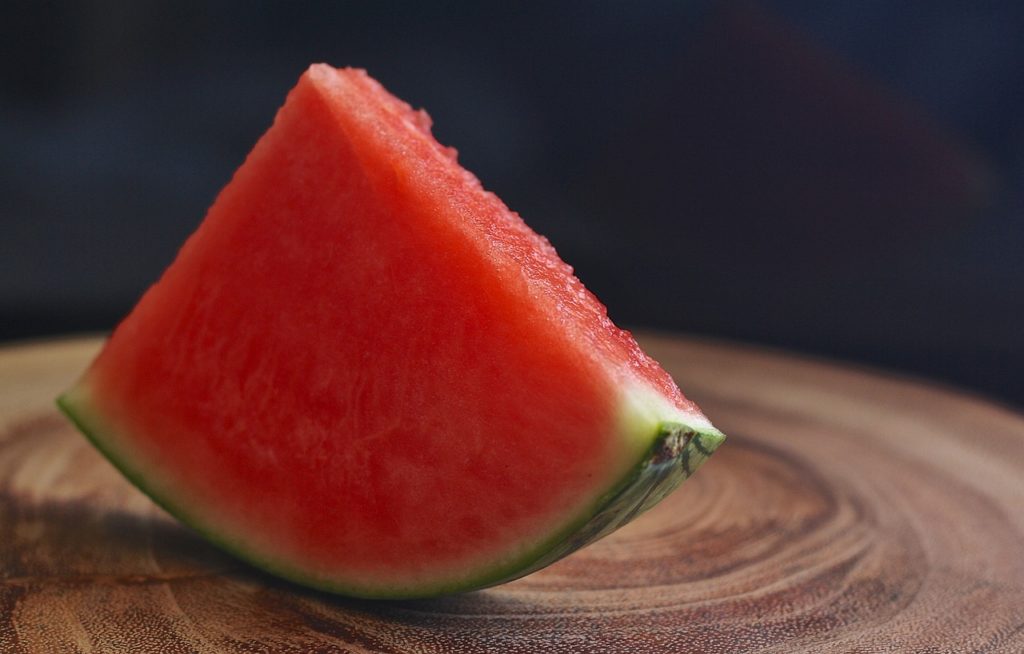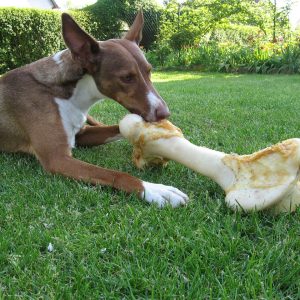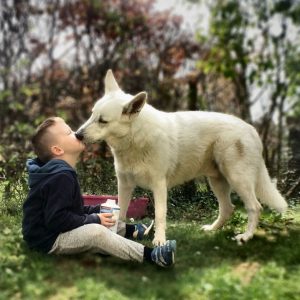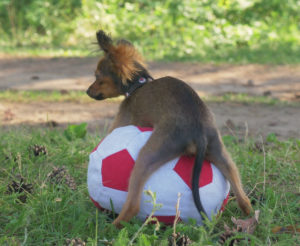Okay, sure – when temperatures start climbing, ice cream sounds amazing. But it has TONS of sugar. So, most of the time, we look for healthy alternatives. And one of the best options out there is watermelon. The juicy bites of red fruit satisfy our sweet tooth without inducing cavities. They also replenish critical water we lose running around in the summer heat. As you chow down, though, you probably notice big puppy eyes peering over the table. Dogs LOVE sharing what we’re having. But before you toss out a bite, you probably hesitate. Can dogs eat watermelon? Not every human food is safe for canines. Not to worry, though. This fruit’s on the approved list – with a few cautions.
Watermelon
Citrullus lanatus is in the Cucurbitaceae family. It hangs out with similar water-filled fruits like cucumber, pumpkin, and squash. (Remember, if the seeds are on the inside, it’s considered a fruit) And it’s one of the better options out there for snacking. One cup of watermelon is only 40 calories – and it contains 92% water. This is why you feel so refreshed after you eat one. You DO get natural sugar (of course), but watermelon packages it in fiber (about 2%, actually). When you insulate sugar in fiber, it releases slowly into the bloodstream, preventing a sudden sugar spike. Which is one of the reasons it’s okay for dogs to eat watermelon.
The other reasons? Watermelon is packed with healthy nutrients:
- Calcium: 10mg
- Iron: 35mcg
- Potassium: 155mg
- Protein: 1g
- Vitamins
- A: 40mcg
- C: 11.5mg
And when dogs eat watermelon, they also get a healthy dose of lycopene. This is what gives the fruit it’s red color, but it’s also an antioxidant that promotes heart health. What canines DON’T get? Sodium, fat, or cholesterol.
Can Dogs Eat Watermelon?
With so many health benefits, dogs can eat watermelon. It’s one of the better treat options out there when they’ve spent the day chasing the frisbee. They’ll get plenty of hydration, with important vitamins and minerals to replace those lost during their activities. In fact, given the option between a slice of watermelon and a handful of treats, odds are your pup will go straight for the watermelon. And those 10.5g of carbohydrates will provide some extra energy to boot.
However, you still need to take some precautions when dogs eat watermelon. It’s a safe treat – when prepared properly.
Precautions When Dogs Eat Watermelon
Seedless watermelon is the safest option for dogs. YOU don’t eat the seeds yourself, and your dog shouldn’t either. Too many seeds can lead to intestinal blockages – especially in smaller breeds. There’s a CHANCE they’ll pass any seeds they ingest, but it’s not worth taking the risk. It’s better to remove any seeds before allowing dogs to eat watermelon. (Or spring for seedless watermelon)
The rind is also problematic. As you go into the greener part of the melon, it grows TOUGH. Your dog can struggle to chew it. Instead, they may attempt to swallow it whole. The tissue won’t break down completely in the stomach, leading to a major obstruction in the GI tract. Remove the rind first (or take the watermelon away when you see your dog reaching that tough layer).
Signs that your dog may have an obstruction?
- Vomiting
- Struggling to pass a bowel movement
- Lethargy
- Abdominal pain
If your dog ate watermelon with seeds or the rind and then demonstrates these signs, you need to get to the veterinarian right away. They’ll perform radiographs or an ultrasound to confirm an obstruction.

Safe Ways for Dogs to Eat Watermelon
You’ve dealt with the seeds and rind, and now you want to figure out the best ways to allow dogs to eat watermelon. No problem! You can serve it fresh, frozen, or dried. Only use REAL watermelon, though. Artificial watermelon contains other ingredients, extra sugar, and artificial sweeteners, such as xylitol. That’s NOT the kind of watermelon dogs can eat!
Fresh Watermelon
Fresh watermelon? There’s nothing better. You can cut it up into convenient cubes (sized for your dog, obviously). Giant breeds often enjoy receiving halved watermelon. Remember to trim away the rind and get rid of as many seeds as you can. If your dog ingests one or two, it won’t be the end of the world, but seeds from the entire fruit? That’s a problem.
Frozen Watermelon
It’s already a hot day – so why not increase the cooling power? You can make yummy frozen watermelon treats for your dog to snack on. An ordinary ice tray works, or you can use other shapes to make the treat more interesting. Blending 2 cups of watermelon with 1 cup of water will make the perfect summer treat to snack on (and you can enjoy one, too!).
Want to add a little something extra? Fill the ice cube tray halfway with non-fat plain yogurt. Then you can add your blended watermelon on top before freezing. This one’s a little tricky as some dogs are allergic to dairy. You’ll want to monitor your pup carefully and portion these treats out to avoid an upset tummy.
Dried Watermelon
Your dog won’t get the hydration replenishment they would with fresh or frozen watermelon, but you CAN make your own watermelon jerky. A dehydrator works quickest, but you CAN use an oven. Cut watermelon into slices and lay them on a sheet tray. Then set your oven to 135 degrees and leave them for 8 hours. (Yeah, it takes that long – which is why most people spring for a dehydrator)
Sweet Summer
Can dogs eat watermelon? Sure! As long as you pluck out the seeds and trim away the rind. They’ll get a healthy dose of vitamins and nutrients, plus a bonus of lots of water. And while there’s natural sugar involved, it won’t spike in their bloodstream the way other sugars can. It’s the perfect summer treat – for everyone!













No comment yet, add your voice below!